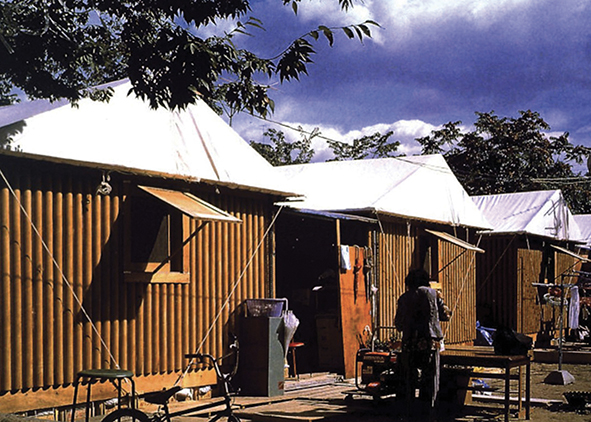Health emergency and impermanence
DOI:
https://doi.org/10.19229/2464-9309/422018Keywords:
time, emergency, health, mobile healthcare modules, humanitarian organizationsAbstract
Answering immediately to a reality increasingly oriented towards quick consumption has originated an architecture highly oriented to the production of temporary and mobile artifacts. The project seizes time and controls its status, becoming a fundamental tool to respond to a continuously evolving reality, often subject of violent and quick transformations, as the ones caused by natural disasters and migrations, resulting from wars or political traumas, giving rise to new forms and systems belonging to a Temporary Architecture that we might call Healthcare. Health Emergency is a reality in our planet’s political, economic and social scene and finds its meaning in emergency for men and caused by man that does not own a cultural and material identity any more but wanders looking for territories that could host him and recognize his right to live.
Downloads
Article Metrics Graph
References
Agier, M. (2008), “Gérer les indésirables: des camps de réfugiés au gouvernement humanitaire”, Flammarion, Paris.
Anzalone, M. (2008), L’urbanistica dell’emergenza – Progettare la flessibilità degli spazi urbani, Alinea Editrice, Firenze.
Baker, L. (2014), Temporary Architecture, Braun publishing AG, Salenstein.
Cidonio, G. (1983), Architettura per il terzo mondo – ipotesi per una metodologia d’intervento, Bulzoni Editore, Roma.
D’Auria, A. (2014), Abitare nell’emergenza – Progettare per il post disastro, EDIFIR, Firenze.
De Giovanni, G. (2005), Architettura dettagliata – Note per una progettazione esecutiva, Il Prato Editore, Saonara (PD).
De Giovanni, G. (2009), “Nanotecnologie per l’Architettura Temporanea”, in Sposito, A. (ed.), Atti del I Convegno Internazionale Nanotech for Architecture – Innovative technologies, techniques and nanostructured materials, Luciano Editore, Napoli, pp. 101-116.
Dostoğlu, N., Eginöz, E. B., Kut, S. and Karacoç, E. (eds) (2016), Architecture in Emergency – Rethinking the refugee crisis, Proceedings, Istanbul Kültür University, Faculty of Architecture, Istanbul.
Fairs, M. (2013), “We have a responsibility to society, says Richard Rogers”, in Dezeen, July 16, 2013. [Online] Available at: www.dezeen.com/2013/07/16/we-have-a-responsibility-to-society-says-richard-rogers/ [Accessed December 4th 2018].
Heidegger, M. (2000), Corpo e spazio, Il Melangolo, Genova.
Horden, R. and Fuchs, U. (2008), Micro, Grafik und Druck GmBH, Munich.
Huber, D. (2017), “Insecurities: Tracing Displacement and Shelter”, in Artforum, vol. 55, n. 5. [Online] Available at: www.artforum.com/print/201701/-65385 [Accessed December 2nd 2018].
Piano, R. (2010), La responsabilità dell’architetto – Conversazione con Renzo Cassigoli, Passigli Editori, Roma.
Rogers, R. and Brown, R. (2018), Un posto per tutti – Vita, architettura e società giusta, Johan & Levi Editore, Monza.
TAMassociati (2016), Taking care – Progettare per il bene comune, Becco Giallo, Padova.
Vaudetti, M., Minucciani, V., Canepa, S. and Saglar Onay, N. (eds) (2018), Suspended Living in Temporary Space – Emergencies in the Mediterranean Region, International Conferences Proceedings 9 October 2017, Politecnico di Torino, Turin, Italy, LetteraVentidue Edizioni, Siracusa.
Terpolilli, C. (2005), “Temporaneo e transitorio nell’architettura contemporanea”, in Terpolli, C. (ed.), Emergenza del progetto – Progetto dell’emergenza – Architetture Con-Temporaneità, Federico Motta Editore, Milano.
Tschumi, B. (2001, III ed.), Architecture and Disjunction, The MIT Press, Cambridge Mass., USA.

Downloads
Published
How to Cite
Issue
Section
License
This Journal is published under Creative Commons Attribution Licence 4.0 (CC-BY).
License scheme | Legal code
This License allows anyone to:
Share: copy and redistribute the material in any medium or format.
Adapt: remix, transform, and build upon the material for any purpose, even commercially.
Under the following terms
Attribution: Users must give appropriate credit, provide a link to the license, and indicate if changes were made; users may do so in any reasonable manner, but not in any way that suggests the licensor endorses them or their use.
No additional restrictions: Users may not apply legal terms or technological measures that legally restrict others from doing anything the license permits.
Notices
Users do not have to comply with the license for elements of the material in the public domain or where your use is permitted by an applicable exception or limitation.
No warranties are given. The license may not give users all of the permissions necessary for their intended use. For example, other rights such as publicity, privacy, or moral rights may limit how you use the material.


















































































